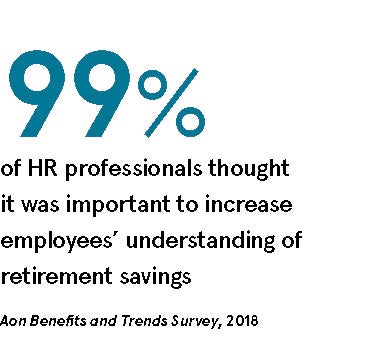While auto-enrolment in workplace pensions means higher employee take-up, this does not necessarily equate to staff engagement or a true understanding of the options.
For employers, improving engagement includes putting in place the right scheme, appropriate charges, strong governance, excellent member education and communication. For employees, it is important to start early, understand key decisions and options, and regularly monitor fund values.
“Delivering desired outcomes remains a question of shared responsibility,” says Martin Parish, workplace pensions proposition lead at pensions and benefits consultancy Aon.
 It is increasingly important to focus on tailoring pension communications to match the life stages and financial considerations of scheme members. This is because a one-size-fits-all approach is no longer enough to motivate engagement.
It is increasingly important to focus on tailoring pension communications to match the life stages and financial considerations of scheme members. This is because a one-size-fits-all approach is no longer enough to motivate engagement.
A recent Aon survey found that 99 per cent of human resources professionals thought it was important to increase employees’ understanding of retirement savings. However, only a quarter of businesses have a related employee value proposition.
“It is crucial that employers think carefully about how they communicate their messages around workplace pensions to ensure maximum involvement from staff,” says Mr Parish. “Even if employers create a great scheme and put a lot of time and effort into it, then it isn’t worth much if the employees then still ignore it or only make minimum contributions.”
It can be helpful for employers to begin by considering the various members of their pension plans and their respective needs in broad terms. As such, Aon illustrates the different needs using several fictional, typical employee characters. These characters are categorised as being millennials, generation Xers and baby boomers, showing how the key considerations around workplace pensions change as time goes by.
“Millennials might look at workplace pensions and engage with them in only a limited way because they’re more concerned with their student debt or taking home as much of their salary as possible,” says Sophia Singleton, head of DC (defined contribution) consulting at Aon. “So the challenge for employers is to emphasise the benefits of workplace pensions and the idea that increasing your contributions early, especially if they’re being matched, can really pay off later in life.”
Successfully helping this group includes encouraging them to register for online access and encouraging higher contributions. This can include communicating the benefit of the company contribution and the tax breaks, and educating on the benefits of compound interest through investing at an early career stage. But it also includes being realistic and providing education on how to tackle debt as they may need to do this before they can start saving.
Meanwhile, gen Xers exemplify the types of people who are mid-way through their careers, often with a family, some of whom may have trigger events, such as having recently been given a pay rise. This is a timely moment for the sponsoring employer to help them to consider their pension strategy more carefully.
“This type of person is likely to be in a workplace pension, but perhaps without really having thought about what it all means and what eventual outcomes would be good to aim for. This is where employers can step in to provide valued guidance and support,” says Ms Singleton. Successful support here might consist of financial wellbeing education, including for the wider family, making the right investment strategy information available and illustrating the potential outcomes of
increased contributions.
Meanwhile, baby boomers and anyone getting towards the latter stages of their full-time working lives will typically have quite different issues in mind as they look to the future and assess their pension options.
“From a contribution point of view it is pretty much too late to begin for the baby boomers, and their considerations are much more about what benefits have been built up, and when and how to retire,” Ms Singleton says. “The aim for employers here should be to ensure that these decision-making processes are as straightforward and painless as possible.”
To help baby boomers, good support would include pre-retirement education, good guidance around flexibility and drawdown, and advice on future investment strategies into retirement.
Using the right tools and providing appropriate information and guidance can make all the difference to outcomes
Although these three character groups illustrate and typify some key ideas around pension needs, it is also very clear that the diversity of concerns among individual employees needs to be considered seriously by employers of all sizes.
Improved communication by employers does not necessarily mean sending out more regular emails. “You can actually overdo this,” Mr Parish says. “So you need to make your communication timely, meaningful and targeted.”
Timely communication means reaching individual employees at key junctures in their working lives. These moments are when people are most likely to consider their pension situation and think seriously about
their finances.
“It’s in these moments when employers need to be able to reach individuals with tailored information, and be clear they can access much more detail and guidance,” Mr Parish says.
Delivering resonant, timely messages and underpinning them with easy access to highly personalised information is now a fundamental part of providing high-calibre workplace pensions. Using the right tools and providing appropriate information and guidance can make all the difference to outcomes. All this is much easier when pension schemes utilise modern, engaging technology platforms such as those used in Aon’s MasterTrust or in its BigBlue Touch Group personal pension offering.
To find out more about how to structure your pension schemes, increase engagement and improve outcomes please call 0344 573 0033 or visit www.aon.com/pensionsengagement

